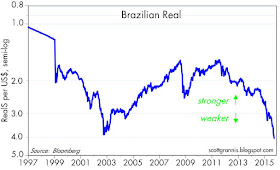Markets continue to be nervous, but not nearly as much as they were a month ago. Oil prices are very low, commodity prices are still drifting lower, and the Brazilian stock market is imploding. But there are signs of stability: the dollar has been flat for the past six months. and swap spreads here and in the Eurozone remain quite low.
Fears are still dominating the market, but they have receded substantially, lifting equity prices from their panic lows of a month ago.
Inflation expectations have fallen, but they are being driven almost exclusively by falling oil prices, as the chart above shows. Longer-term inflation expectations (e.g., the Fed's favorite—the 5-yr, 5-yr forward breakeven rate on TIPS) are still close to historical norms: just shy of 2%, whereas the CPI has risen an annualized 2% over the past 10 years. This tells us that the current fears are not related to deflation, since there is no sign here that the Fed is being too tight.
Commodity prices tend to move inversely to the value of the dollar, as the chart above shows. But the recent relative stability of the dollar (flat for the past six months) suggests that commodity prices are not being pressured by overly-tight monetary policy. More likely, commodities are being driven by weak demand from China, while supplies of commodities are up in a delayed response to their very high prices of just a few years ago. In contrast, the big increase in the dollar in the early 2000s was a sign of very tight money, and commodity prices were much lower then than they are now.
Credit spreads are elevated, but not by enough to signal widespread distress. Most of the damage is confined to the HY energy sector, where spreads today reached 1011 bps—still shy of their August 24th high of 1054. We continue to see the notable disconnect between credit and swap spreads (top chart). This suggests that the underlying fundamentals of the economy and the financial markets are still quite healthy, and that the distress in the energy sector is not spreading to other sectors.
Brazil, however, is in deep trouble. In dollar terms, the Brazilian stock market is down an astonishing 75% over the past five years. About half of this decline is due to the plunging real, which is now at a new all-time low of 4.05 to the dollar. Either way you measure it, this is a world-class, super-ugly bear market. From a contrarian perspective, however, the recent decline is beginning to look like the kind of panic selling that marks major market bottoms.








you are not well informed on the HY market.
ReplyDeleteLows and highs are often re-tested, most likely we will retest the August lows over the next 10 days....Markets should be worried. China is imploding..much more than we know...
ReplyDeleteWalls of worries sometimes do tumble down....
I'm not necessarily agreeing with marcusbalbus but HY def under more stress than you give it credit for (no pun intended), I've been trading this market for 25 yrs and I can tell you it is looking for a bid and not finding it. Not necessarily portending anything pernicious but not good news either.
ReplyDeleteHousing costs are preventing outright deflation in the United States.
ReplyDeleteUnfortunately, robust housing construction is criminalized in most US cities. Zoning.
Look for lower inflation and interest rates ahead.